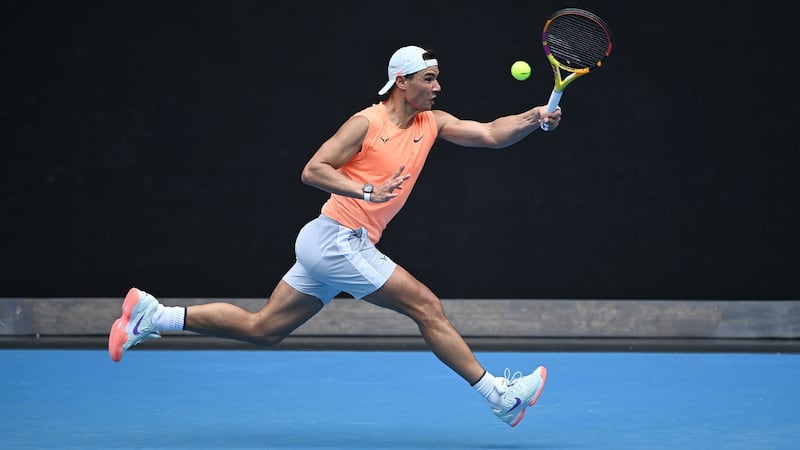Australia’s reputation as the lucky country is going to look apt when the first grand slam tennis tournament of 2021 starts in Melbourne on Monday.
Tuning into Eurosport's Australian Open coverage, enviously looking at pictures of blazing southern hemisphere sunshine in the middle of a cold northern winter, had become a ritual even in the best of times.
During these grim times the action in Melbourne Park is starting three weeks later than normal due to the pandemic.
But from a local perspective of lockdown, rampant Covid-19 infection rates, and even the weather turning nastier, Australia will look luckier than ever during the coming fortnight.
Elite competition taking place not only in sunshine but also, crucially, in front of spectators, supplies a rare slice of sporting solace.
Up to 30,000 fans are permitted to watch Djokovic, Williams, Nadal & Co every day; actually buy a ticket, hop on the train and sit in the shade in shorts and sunnies in as close to an approximation of normal as sport has seen in nearly a year.
One local politician in Victoria has described it as “the most significant international event with crowds that the world has seen for many, many months.”
He’s right too. So right that it will be almost jarring for eyes from this part of the world to watch sport in its natural habitat of dramatic human colour rather than a functional monochrome exercise in keeping things ticking over.
The contrast with the bleak outlook for sport closer to home is stark. Any idea of the public being allowed go to a game in numbers before the summer seems far-fetched such is the public health reality here.
How so many have lost so much puts inability to attend events in sharp context. Nevertheless the hollow experience that so much sport has been revealed to be in the absence of crowds cannot be ignored. Nor can how keenly that absence is felt by so many.
Vibrant
It will be one of the most vibrant and vivid experiences when the pandemic has been brought under control, the simple act of thousands of people shoulder to shoulder, revelling in the gloriously frivolous act of investing far too much importance into the puck of a ball or a close photo-finish.
It seems a distant prospect and the discrepancy with what is happening in Melbourne will perhaps underline wider debates about how Australia’s success in combating the Covid-19 threat has little to do with luck but rather undertaking the sort of decisive action so notably absent elsewhere.
For now though it will feel like an almost giddy experience to watch on screen from the other side of the world what hopefully might be a reality here sooner rather than later.
The success of that decisive public health action by the Australian authorities underlines though how much political capital the authorities down under have invested in ensuring the Open goes ahead. Justifiable satisfaction at it starting will evaporate quickly if things start to do wrong.
That’s because in any environment there is a calculated risk involved in allowing large numbers of people gather. The consequences of getting that calculation wrong have been dreadfully obvious almost everywhere.

It’s why in addition to the work of putting in place exhaustive safety measures, a sizable dollop of good fortune still won’t be superfluous in making this a successful Open.
The health statistics involved in Australia are startlingly low by European standards. Keeping them like that means pulling the plug on spectators can’t be ruled out. After all the pay-off for taking such decisive action is reflected in people’s enviable everyday existence by current Irish standards.
The question of maintaining that has provoked lots of public debate in Melbourne. Is a tennis tournament worth the risk of allowing in over a thousand visitors from countries around the world that are ravaged with Covid, especially when some locals stranded abroad aren’t allowed home.
It underscores how tennis has a lot riding on getting this Australian Open right too. It has not had a good pandemic. Of all the major sports tennis has appeared the one most out of touch due to a series of tone-deaf cock-ups.
It's easy, perhaps too easy, to pin much of it on perhaps its most high-profile star, the men's No 1 Novak Djokovic.
Polarising
The Serb has always been a polarising figure. But whether it be controversial views on vaccination, or the moronic decision to hold exhibition tournaments with spectators last summer, his claims to being simply misunderstood have had to be trotted out too often for them to be convincing.
He has also been the face of player unhappiness about quarantine procedures that required them to stay in hotel rooms for 14 days on arrival in Australia. In the circumstances the anger that greeted ‘The Joker’ and his demands for special treatment for players was comparably restrained.
However Djokovic’s point that he was merely reflecting much wider opinions and unhappiness among colleagues isn’t without merit.
Coverage of some of the world’s best players complaining bitterly about supposedly penal conditions, including the supposed indignity of smacking balls off upturned mattresses, featured many more people besides the men’s No. 1. All of it smacked of unsavoury sporting privilege.
The much more substantial privilege Melbourne allows now is an opportunity to watch sport approaching how it should be.
Over the coming two weeks Serena Williams may equal Margaret Court's record 24 grand slam single titles. Rafa Nadal might overcome a bad back to finally eclipse Roger Federer and move to a 21th slam. Djokovic himself might even secure a scarcely credible ninth victory in Melbourne.
The significance of such things always needs to be kept in perspective. The risk-reward balance must always lean heavily towards prudence. But this is an Australian Open that can provide a tantalising glimpse of what might be in prospect for everyone later this year.












